Managerial Decision Making Report: Solution & Implementation Plan
VerifiedAdded on 2022/09/27
|11
|3445
|17
Report
AI Summary
This report delves into the realm of managerial decision-making, focusing on a real-world problem of low employee motivation and job satisfaction. It begins by outlining the problem's background and defining its root causes, which are identified as lack of promotion opportunities, inadequate pay, and insufficient support from management. The report then explores various problem-solving frameworks, including the Ishikawa diagram, Pareto analysis, and the 5Ws, to generate potential solutions. Solution generation involves methods like trial and error, difference reduction, and means-ends analysis, while solution evaluation emphasizes a weighted evaluation matrix to assess the effectiveness of proposed solutions. Key solutions include fostering a positive work environment, providing rewards and recognition, and offering training and development opportunities. Finally, the report outlines an implementation and action plan, emphasizing the importance of monitoring and evaluating performance to ensure the effectiveness of the implemented strategies. The report aims to provide practical insights into improving employee morale, job satisfaction, and overall organizational performance.
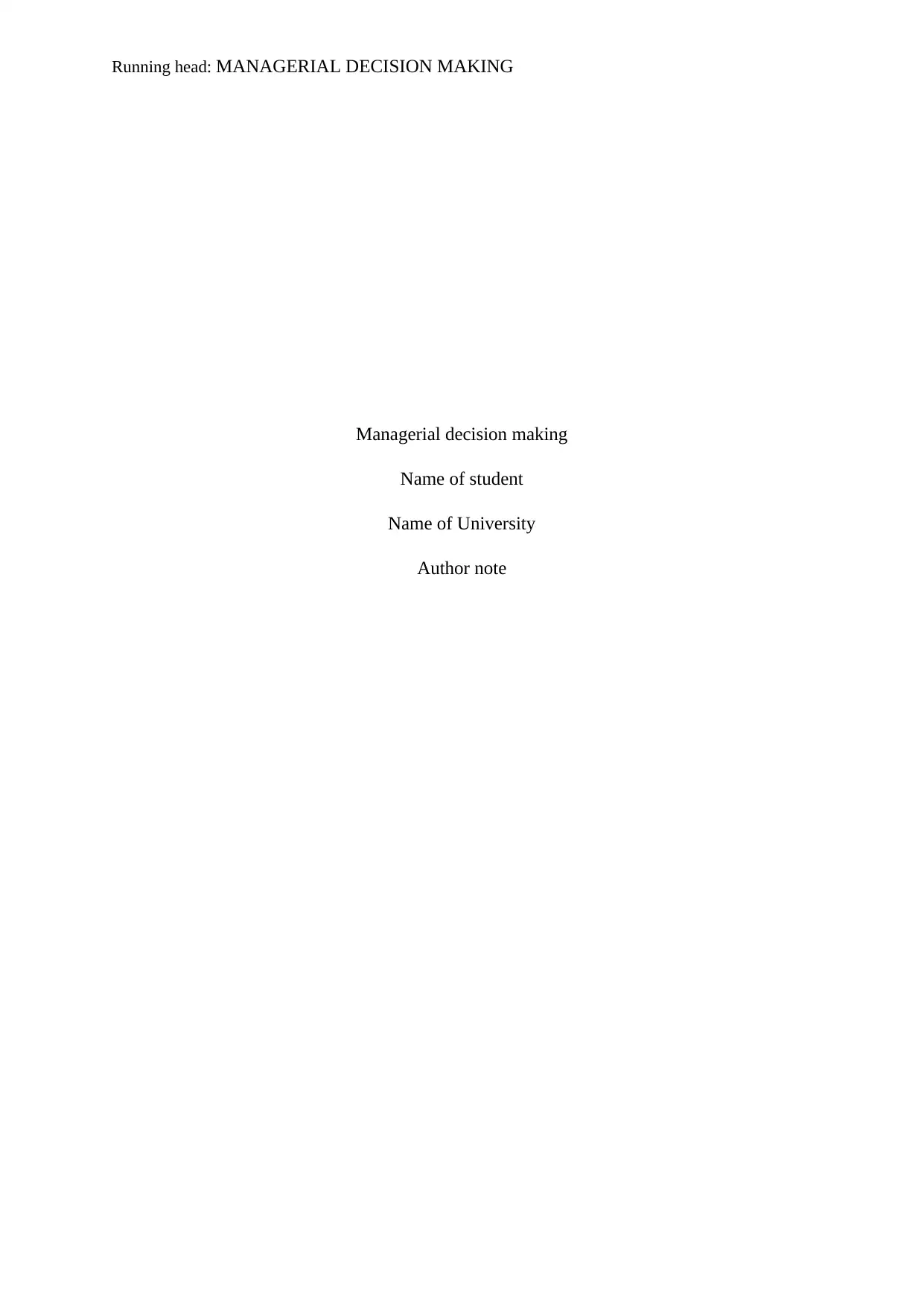
Running head: MANAGERIAL DECISION MAKING
Managerial decision making
Name of student
Name of University
Author note
Managerial decision making
Name of student
Name of University
Author note
Paraphrase This Document
Need a fresh take? Get an instant paraphrase of this document with our AI Paraphraser
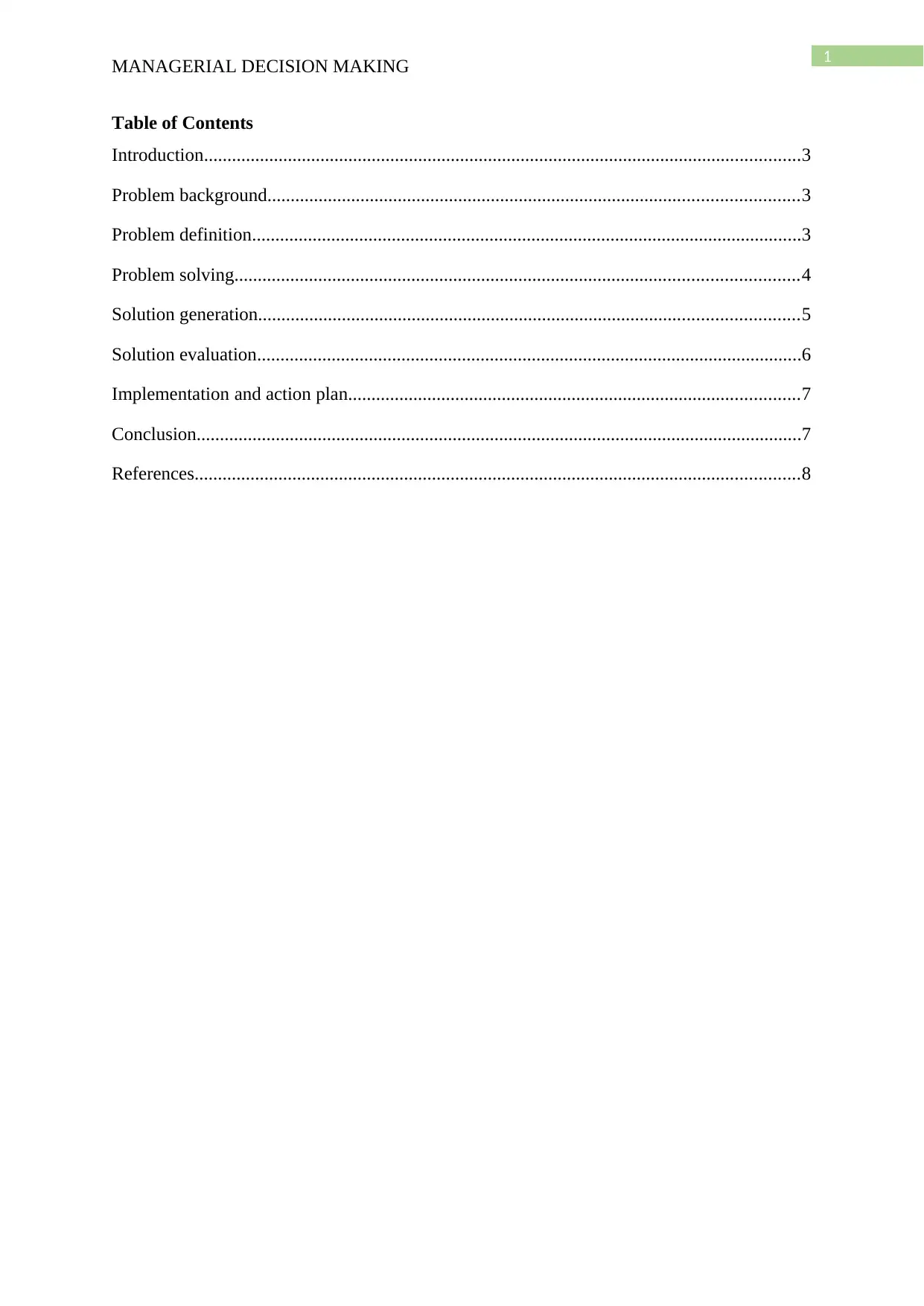
1
MANAGERIAL DECISION MAKING
Table of Contents
Introduction................................................................................................................................3
Problem background..................................................................................................................3
Problem definition......................................................................................................................3
Problem solving.........................................................................................................................4
Solution generation....................................................................................................................5
Solution evaluation.....................................................................................................................6
Implementation and action plan.................................................................................................7
Conclusion..................................................................................................................................7
References..................................................................................................................................8
MANAGERIAL DECISION MAKING
Table of Contents
Introduction................................................................................................................................3
Problem background..................................................................................................................3
Problem definition......................................................................................................................3
Problem solving.........................................................................................................................4
Solution generation....................................................................................................................5
Solution evaluation.....................................................................................................................6
Implementation and action plan.................................................................................................7
Conclusion..................................................................................................................................7
References..................................................................................................................................8
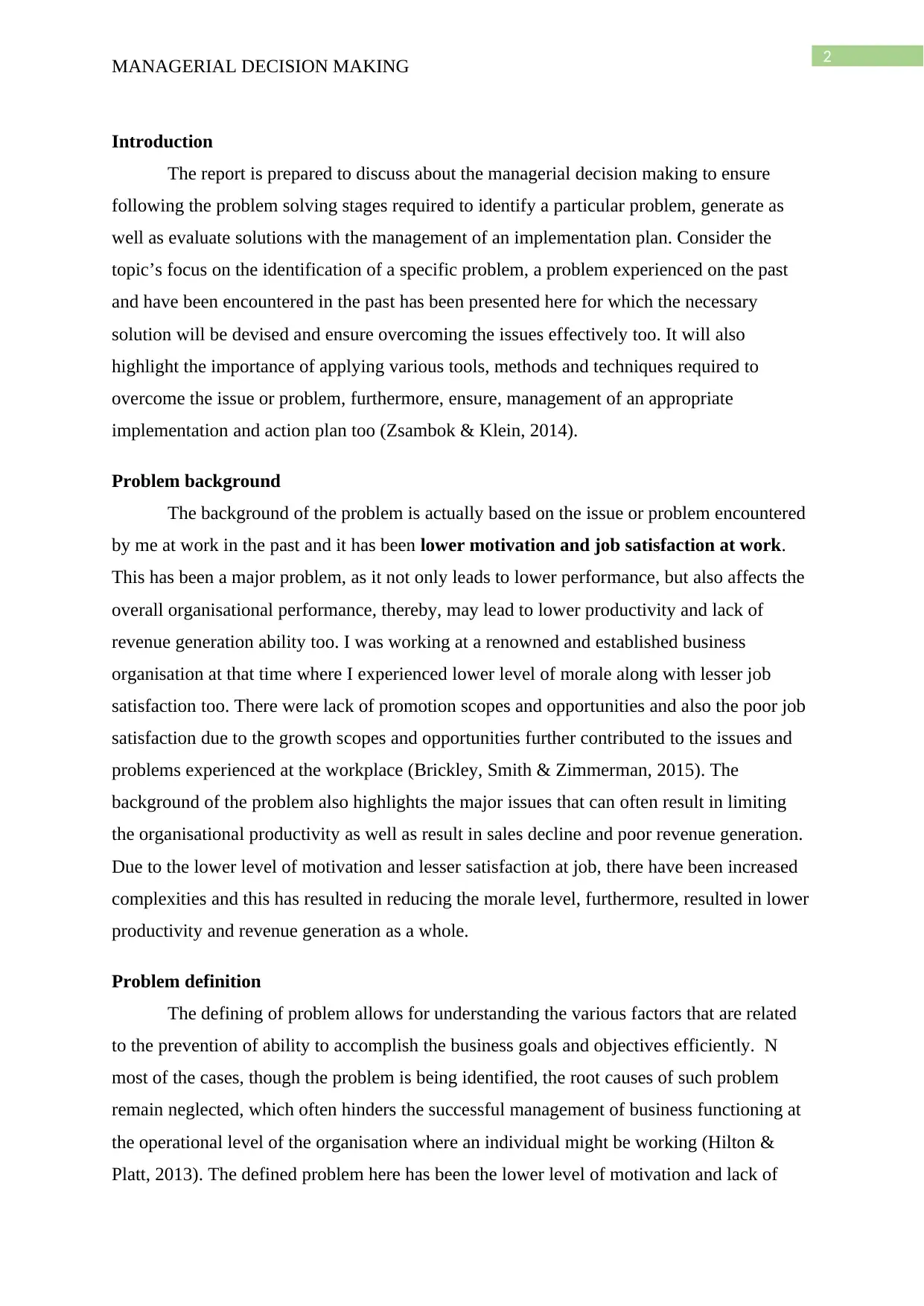
2
MANAGERIAL DECISION MAKING
Introduction
The report is prepared to discuss about the managerial decision making to ensure
following the problem solving stages required to identify a particular problem, generate as
well as evaluate solutions with the management of an implementation plan. Consider the
topic’s focus on the identification of a specific problem, a problem experienced on the past
and have been encountered in the past has been presented here for which the necessary
solution will be devised and ensure overcoming the issues effectively too. It will also
highlight the importance of applying various tools, methods and techniques required to
overcome the issue or problem, furthermore, ensure, management of an appropriate
implementation and action plan too (Zsambok & Klein, 2014).
Problem background
The background of the problem is actually based on the issue or problem encountered
by me at work in the past and it has been lower motivation and job satisfaction at work.
This has been a major problem, as it not only leads to lower performance, but also affects the
overall organisational performance, thereby, may lead to lower productivity and lack of
revenue generation ability too. I was working at a renowned and established business
organisation at that time where I experienced lower level of morale along with lesser job
satisfaction too. There were lack of promotion scopes and opportunities and also the poor job
satisfaction due to the growth scopes and opportunities further contributed to the issues and
problems experienced at the workplace (Brickley, Smith & Zimmerman, 2015). The
background of the problem also highlights the major issues that can often result in limiting
the organisational productivity as well as result in sales decline and poor revenue generation.
Due to the lower level of motivation and lesser satisfaction at job, there have been increased
complexities and this has resulted in reducing the morale level, furthermore, resulted in lower
productivity and revenue generation as a whole.
Problem definition
The defining of problem allows for understanding the various factors that are related
to the prevention of ability to accomplish the business goals and objectives efficiently. N
most of the cases, though the problem is being identified, the root causes of such problem
remain neglected, which often hinders the successful management of business functioning at
the operational level of the organisation where an individual might be working (Hilton &
Platt, 2013). The defined problem here has been the lower level of motivation and lack of
MANAGERIAL DECISION MAKING
Introduction
The report is prepared to discuss about the managerial decision making to ensure
following the problem solving stages required to identify a particular problem, generate as
well as evaluate solutions with the management of an implementation plan. Consider the
topic’s focus on the identification of a specific problem, a problem experienced on the past
and have been encountered in the past has been presented here for which the necessary
solution will be devised and ensure overcoming the issues effectively too. It will also
highlight the importance of applying various tools, methods and techniques required to
overcome the issue or problem, furthermore, ensure, management of an appropriate
implementation and action plan too (Zsambok & Klein, 2014).
Problem background
The background of the problem is actually based on the issue or problem encountered
by me at work in the past and it has been lower motivation and job satisfaction at work.
This has been a major problem, as it not only leads to lower performance, but also affects the
overall organisational performance, thereby, may lead to lower productivity and lack of
revenue generation ability too. I was working at a renowned and established business
organisation at that time where I experienced lower level of morale along with lesser job
satisfaction too. There were lack of promotion scopes and opportunities and also the poor job
satisfaction due to the growth scopes and opportunities further contributed to the issues and
problems experienced at the workplace (Brickley, Smith & Zimmerman, 2015). The
background of the problem also highlights the major issues that can often result in limiting
the organisational productivity as well as result in sales decline and poor revenue generation.
Due to the lower level of motivation and lesser satisfaction at job, there have been increased
complexities and this has resulted in reducing the morale level, furthermore, resulted in lower
productivity and revenue generation as a whole.
Problem definition
The defining of problem allows for understanding the various factors that are related
to the prevention of ability to accomplish the business goals and objectives efficiently. N
most of the cases, though the problem is being identified, the root causes of such problem
remain neglected, which often hinders the successful management of business functioning at
the operational level of the organisation where an individual might be working (Hilton &
Platt, 2013). The defined problem here has been the lower level of motivation and lack of
⊘ This is a preview!⊘
Do you want full access?
Subscribe today to unlock all pages.

Trusted by 1+ million students worldwide
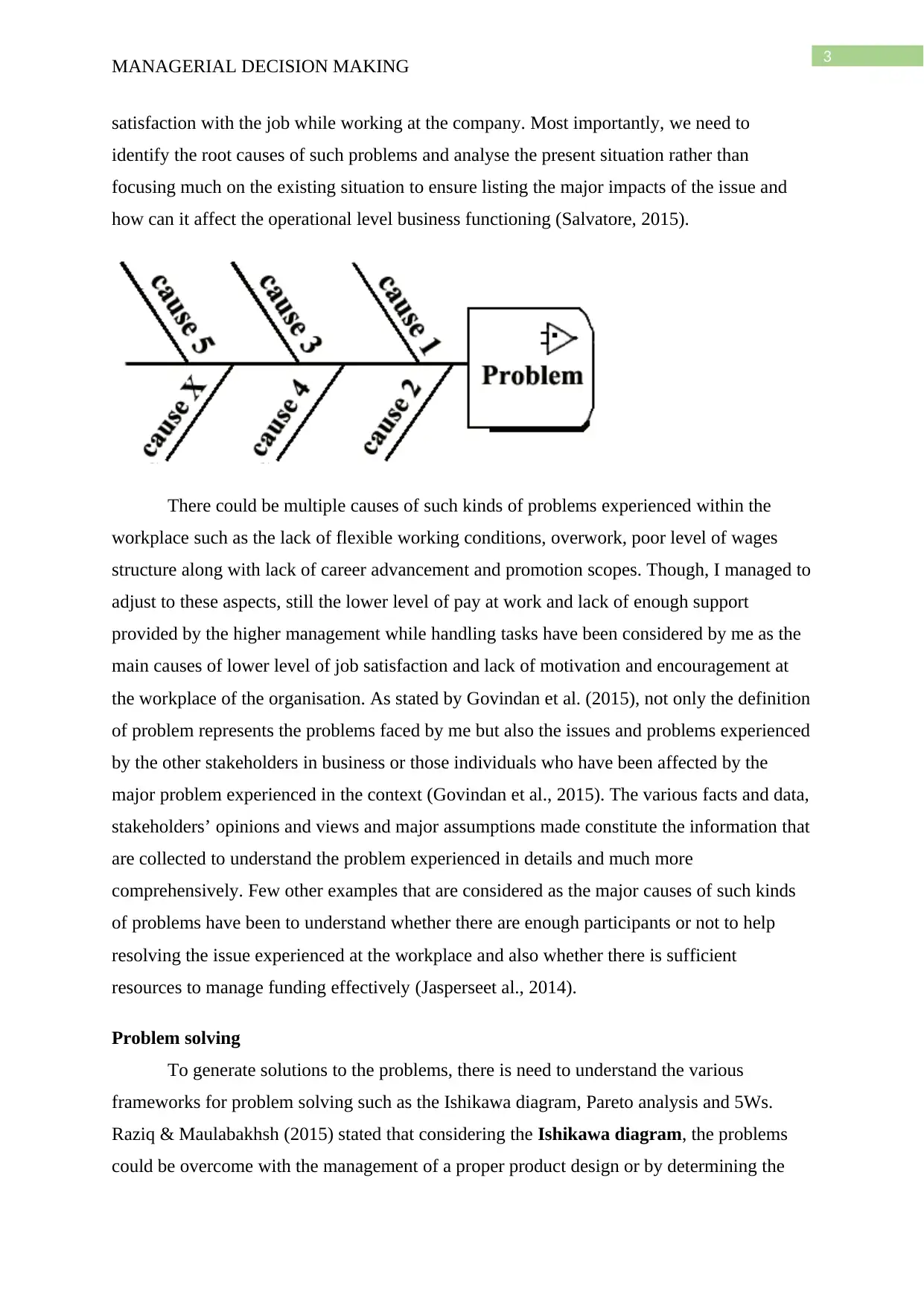
3
MANAGERIAL DECISION MAKING
satisfaction with the job while working at the company. Most importantly, we need to
identify the root causes of such problems and analyse the present situation rather than
focusing much on the existing situation to ensure listing the major impacts of the issue and
how can it affect the operational level business functioning (Salvatore, 2015).
There could be multiple causes of such kinds of problems experienced within the
workplace such as the lack of flexible working conditions, overwork, poor level of wages
structure along with lack of career advancement and promotion scopes. Though, I managed to
adjust to these aspects, still the lower level of pay at work and lack of enough support
provided by the higher management while handling tasks have been considered by me as the
main causes of lower level of job satisfaction and lack of motivation and encouragement at
the workplace of the organisation. As stated by Govindan et al. (2015), not only the definition
of problem represents the problems faced by me but also the issues and problems experienced
by the other stakeholders in business or those individuals who have been affected by the
major problem experienced in the context (Govindan et al., 2015). The various facts and data,
stakeholders’ opinions and views and major assumptions made constitute the information that
are collected to understand the problem experienced in details and much more
comprehensively. Few other examples that are considered as the major causes of such kinds
of problems have been to understand whether there are enough participants or not to help
resolving the issue experienced at the workplace and also whether there is sufficient
resources to manage funding effectively (Jasperseet al., 2014).
Problem solving
To generate solutions to the problems, there is need to understand the various
frameworks for problem solving such as the Ishikawa diagram, Pareto analysis and 5Ws.
Raziq & Maulabakhsh (2015) stated that considering the Ishikawa diagram, the problems
could be overcome with the management of a proper product design or by determining the
MANAGERIAL DECISION MAKING
satisfaction with the job while working at the company. Most importantly, we need to
identify the root causes of such problems and analyse the present situation rather than
focusing much on the existing situation to ensure listing the major impacts of the issue and
how can it affect the operational level business functioning (Salvatore, 2015).
There could be multiple causes of such kinds of problems experienced within the
workplace such as the lack of flexible working conditions, overwork, poor level of wages
structure along with lack of career advancement and promotion scopes. Though, I managed to
adjust to these aspects, still the lower level of pay at work and lack of enough support
provided by the higher management while handling tasks have been considered by me as the
main causes of lower level of job satisfaction and lack of motivation and encouragement at
the workplace of the organisation. As stated by Govindan et al. (2015), not only the definition
of problem represents the problems faced by me but also the issues and problems experienced
by the other stakeholders in business or those individuals who have been affected by the
major problem experienced in the context (Govindan et al., 2015). The various facts and data,
stakeholders’ opinions and views and major assumptions made constitute the information that
are collected to understand the problem experienced in details and much more
comprehensively. Few other examples that are considered as the major causes of such kinds
of problems have been to understand whether there are enough participants or not to help
resolving the issue experienced at the workplace and also whether there is sufficient
resources to manage funding effectively (Jasperseet al., 2014).
Problem solving
To generate solutions to the problems, there is need to understand the various
frameworks for problem solving such as the Ishikawa diagram, Pareto analysis and 5Ws.
Raziq & Maulabakhsh (2015) stated that considering the Ishikawa diagram, the problems
could be overcome with the management of a proper product design or by determining the
Paraphrase This Document
Need a fresh take? Get an instant paraphrase of this document with our AI Paraphraser
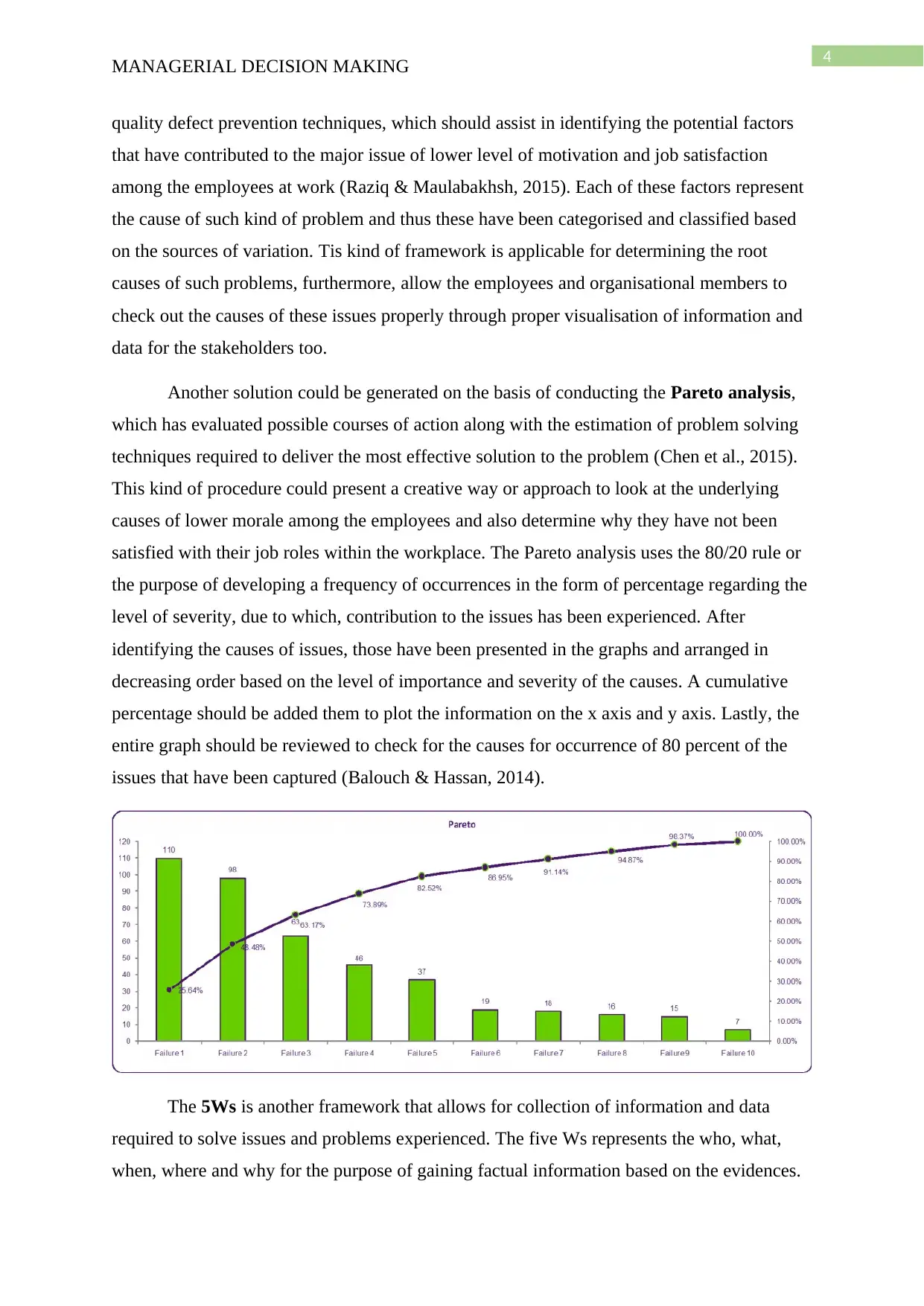
4
MANAGERIAL DECISION MAKING
quality defect prevention techniques, which should assist in identifying the potential factors
that have contributed to the major issue of lower level of motivation and job satisfaction
among the employees at work (Raziq & Maulabakhsh, 2015). Each of these factors represent
the cause of such kind of problem and thus these have been categorised and classified based
on the sources of variation. Tis kind of framework is applicable for determining the root
causes of such problems, furthermore, allow the employees and organisational members to
check out the causes of these issues properly through proper visualisation of information and
data for the stakeholders too.
Another solution could be generated on the basis of conducting the Pareto analysis,
which has evaluated possible courses of action along with the estimation of problem solving
techniques required to deliver the most effective solution to the problem (Chen et al., 2015).
This kind of procedure could present a creative way or approach to look at the underlying
causes of lower morale among the employees and also determine why they have not been
satisfied with their job roles within the workplace. The Pareto analysis uses the 80/20 rule or
the purpose of developing a frequency of occurrences in the form of percentage regarding the
level of severity, due to which, contribution to the issues has been experienced. After
identifying the causes of issues, those have been presented in the graphs and arranged in
decreasing order based on the level of importance and severity of the causes. A cumulative
percentage should be added them to plot the information on the x axis and y axis. Lastly, the
entire graph should be reviewed to check for the causes for occurrence of 80 percent of the
issues that have been captured (Balouch & Hassan, 2014).
The 5Ws is another framework that allows for collection of information and data
required to solve issues and problems experienced. The five Ws represents the who, what,
when, where and why for the purpose of gaining factual information based on the evidences.
MANAGERIAL DECISION MAKING
quality defect prevention techniques, which should assist in identifying the potential factors
that have contributed to the major issue of lower level of motivation and job satisfaction
among the employees at work (Raziq & Maulabakhsh, 2015). Each of these factors represent
the cause of such kind of problem and thus these have been categorised and classified based
on the sources of variation. Tis kind of framework is applicable for determining the root
causes of such problems, furthermore, allow the employees and organisational members to
check out the causes of these issues properly through proper visualisation of information and
data for the stakeholders too.
Another solution could be generated on the basis of conducting the Pareto analysis,
which has evaluated possible courses of action along with the estimation of problem solving
techniques required to deliver the most effective solution to the problem (Chen et al., 2015).
This kind of procedure could present a creative way or approach to look at the underlying
causes of lower morale among the employees and also determine why they have not been
satisfied with their job roles within the workplace. The Pareto analysis uses the 80/20 rule or
the purpose of developing a frequency of occurrences in the form of percentage regarding the
level of severity, due to which, contribution to the issues has been experienced. After
identifying the causes of issues, those have been presented in the graphs and arranged in
decreasing order based on the level of importance and severity of the causes. A cumulative
percentage should be added them to plot the information on the x axis and y axis. Lastly, the
entire graph should be reviewed to check for the causes for occurrence of 80 percent of the
issues that have been captured (Balouch & Hassan, 2014).
The 5Ws is another framework that allows for collection of information and data
required to solve issues and problems experienced. The five Ws represents the who, what,
when, where and why for the purpose of gaining factual information based on the evidences.
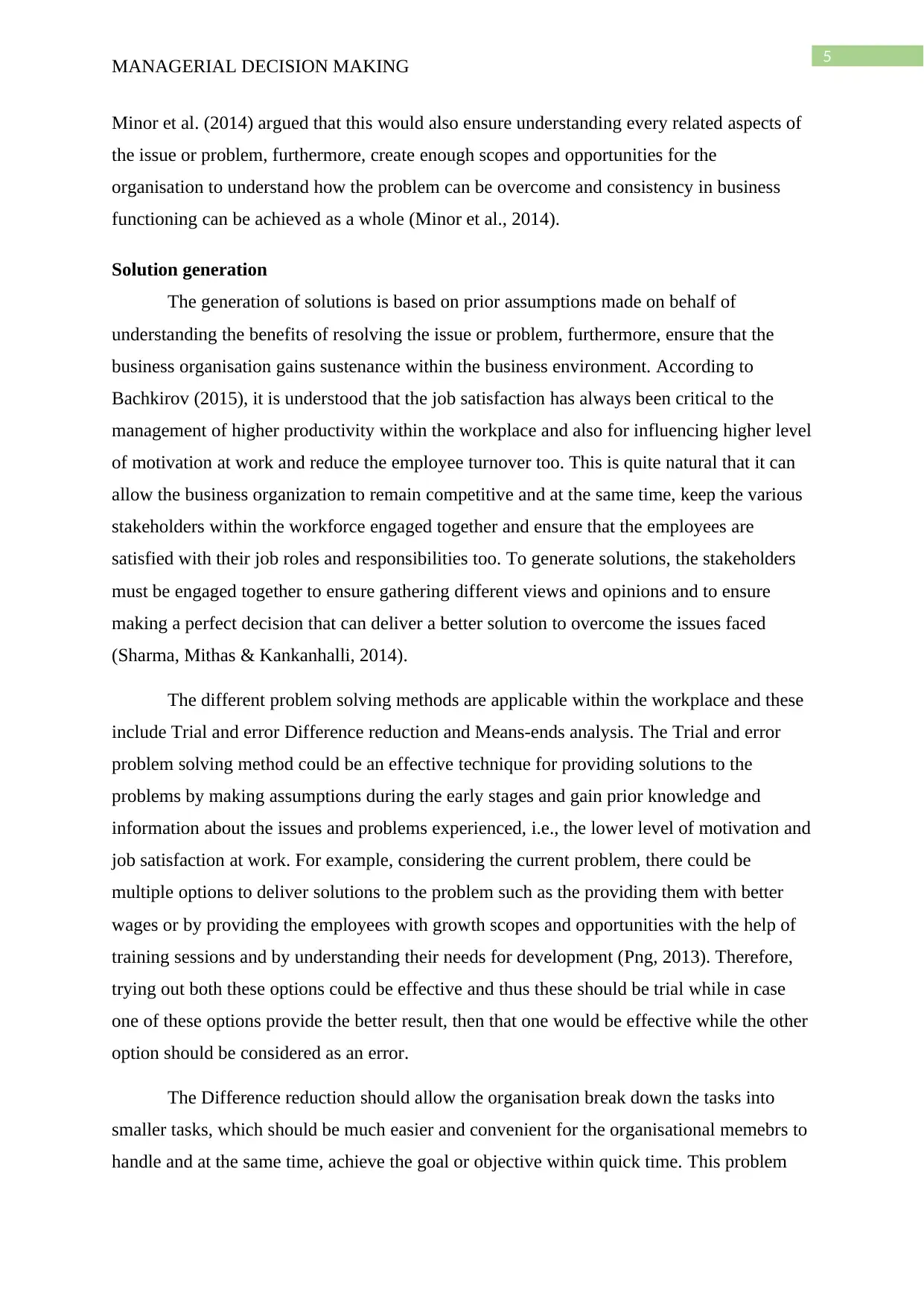
5
MANAGERIAL DECISION MAKING
Minor et al. (2014) argued that this would also ensure understanding every related aspects of
the issue or problem, furthermore, create enough scopes and opportunities for the
organisation to understand how the problem can be overcome and consistency in business
functioning can be achieved as a whole (Minor et al., 2014).
Solution generation
The generation of solutions is based on prior assumptions made on behalf of
understanding the benefits of resolving the issue or problem, furthermore, ensure that the
business organisation gains sustenance within the business environment. According to
Bachkirov (2015), it is understood that the job satisfaction has always been critical to the
management of higher productivity within the workplace and also for influencing higher level
of motivation at work and reduce the employee turnover too. This is quite natural that it can
allow the business organization to remain competitive and at the same time, keep the various
stakeholders within the workforce engaged together and ensure that the employees are
satisfied with their job roles and responsibilities too. To generate solutions, the stakeholders
must be engaged together to ensure gathering different views and opinions and to ensure
making a perfect decision that can deliver a better solution to overcome the issues faced
(Sharma, Mithas & Kankanhalli, 2014).
The different problem solving methods are applicable within the workplace and these
include Trial and error Difference reduction and Means-ends analysis. The Trial and error
problem solving method could be an effective technique for providing solutions to the
problems by making assumptions during the early stages and gain prior knowledge and
information about the issues and problems experienced, i.e., the lower level of motivation and
job satisfaction at work. For example, considering the current problem, there could be
multiple options to deliver solutions to the problem such as the providing them with better
wages or by providing the employees with growth scopes and opportunities with the help of
training sessions and by understanding their needs for development (Png, 2013). Therefore,
trying out both these options could be effective and thus these should be trial while in case
one of these options provide the better result, then that one would be effective while the other
option should be considered as an error.
The Difference reduction should allow the organisation break down the tasks into
smaller tasks, which should be much easier and convenient for the organisational memebrs to
handle and at the same time, achieve the goal or objective within quick time. This problem
MANAGERIAL DECISION MAKING
Minor et al. (2014) argued that this would also ensure understanding every related aspects of
the issue or problem, furthermore, create enough scopes and opportunities for the
organisation to understand how the problem can be overcome and consistency in business
functioning can be achieved as a whole (Minor et al., 2014).
Solution generation
The generation of solutions is based on prior assumptions made on behalf of
understanding the benefits of resolving the issue or problem, furthermore, ensure that the
business organisation gains sustenance within the business environment. According to
Bachkirov (2015), it is understood that the job satisfaction has always been critical to the
management of higher productivity within the workplace and also for influencing higher level
of motivation at work and reduce the employee turnover too. This is quite natural that it can
allow the business organization to remain competitive and at the same time, keep the various
stakeholders within the workforce engaged together and ensure that the employees are
satisfied with their job roles and responsibilities too. To generate solutions, the stakeholders
must be engaged together to ensure gathering different views and opinions and to ensure
making a perfect decision that can deliver a better solution to overcome the issues faced
(Sharma, Mithas & Kankanhalli, 2014).
The different problem solving methods are applicable within the workplace and these
include Trial and error Difference reduction and Means-ends analysis. The Trial and error
problem solving method could be an effective technique for providing solutions to the
problems by making assumptions during the early stages and gain prior knowledge and
information about the issues and problems experienced, i.e., the lower level of motivation and
job satisfaction at work. For example, considering the current problem, there could be
multiple options to deliver solutions to the problem such as the providing them with better
wages or by providing the employees with growth scopes and opportunities with the help of
training sessions and by understanding their needs for development (Png, 2013). Therefore,
trying out both these options could be effective and thus these should be trial while in case
one of these options provide the better result, then that one would be effective while the other
option should be considered as an error.
The Difference reduction should allow the organisation break down the tasks into
smaller tasks, which should be much easier and convenient for the organisational memebrs to
handle and at the same time, achieve the goal or objective within quick time. This problem
⊘ This is a preview!⊘
Do you want full access?
Subscribe today to unlock all pages.

Trusted by 1+ million students worldwide
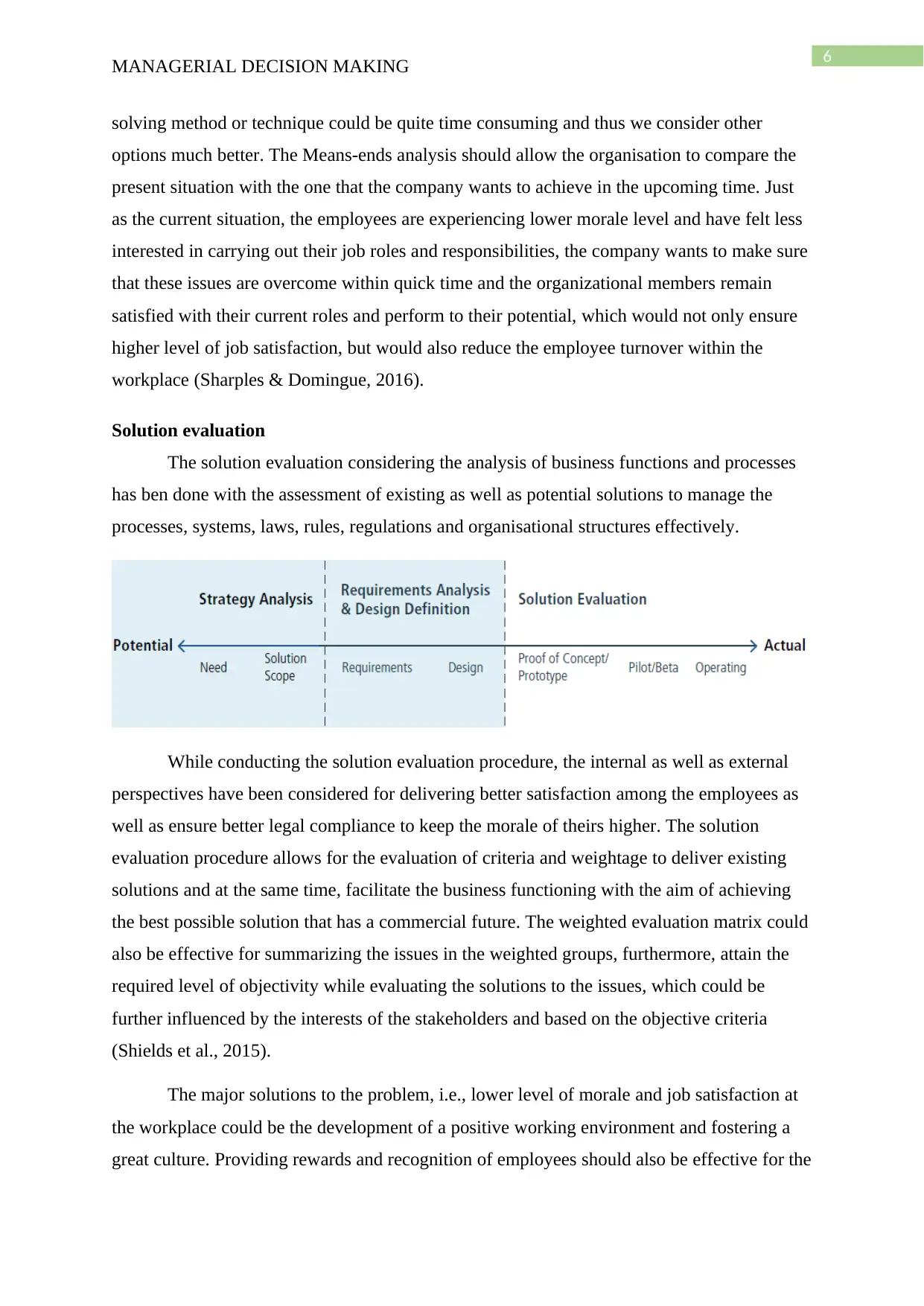
6
MANAGERIAL DECISION MAKING
solving method or technique could be quite time consuming and thus we consider other
options much better. The Means-ends analysis should allow the organisation to compare the
present situation with the one that the company wants to achieve in the upcoming time. Just
as the current situation, the employees are experiencing lower morale level and have felt less
interested in carrying out their job roles and responsibilities, the company wants to make sure
that these issues are overcome within quick time and the organizational members remain
satisfied with their current roles and perform to their potential, which would not only ensure
higher level of job satisfaction, but would also reduce the employee turnover within the
workplace (Sharples & Domingue, 2016).
Solution evaluation
The solution evaluation considering the analysis of business functions and processes
has ben done with the assessment of existing as well as potential solutions to manage the
processes, systems, laws, rules, regulations and organisational structures effectively.
While conducting the solution evaluation procedure, the internal as well as external
perspectives have been considered for delivering better satisfaction among the employees as
well as ensure better legal compliance to keep the morale of theirs higher. The solution
evaluation procedure allows for the evaluation of criteria and weightage to deliver existing
solutions and at the same time, facilitate the business functioning with the aim of achieving
the best possible solution that has a commercial future. The weighted evaluation matrix could
also be effective for summarizing the issues in the weighted groups, furthermore, attain the
required level of objectivity while evaluating the solutions to the issues, which could be
further influenced by the interests of the stakeholders and based on the objective criteria
(Shields et al., 2015).
The major solutions to the problem, i.e., lower level of morale and job satisfaction at
the workplace could be the development of a positive working environment and fostering a
great culture. Providing rewards and recognition of employees should also be effective for the
MANAGERIAL DECISION MAKING
solving method or technique could be quite time consuming and thus we consider other
options much better. The Means-ends analysis should allow the organisation to compare the
present situation with the one that the company wants to achieve in the upcoming time. Just
as the current situation, the employees are experiencing lower morale level and have felt less
interested in carrying out their job roles and responsibilities, the company wants to make sure
that these issues are overcome within quick time and the organizational members remain
satisfied with their current roles and perform to their potential, which would not only ensure
higher level of job satisfaction, but would also reduce the employee turnover within the
workplace (Sharples & Domingue, 2016).
Solution evaluation
The solution evaluation considering the analysis of business functions and processes
has ben done with the assessment of existing as well as potential solutions to manage the
processes, systems, laws, rules, regulations and organisational structures effectively.
While conducting the solution evaluation procedure, the internal as well as external
perspectives have been considered for delivering better satisfaction among the employees as
well as ensure better legal compliance to keep the morale of theirs higher. The solution
evaluation procedure allows for the evaluation of criteria and weightage to deliver existing
solutions and at the same time, facilitate the business functioning with the aim of achieving
the best possible solution that has a commercial future. The weighted evaluation matrix could
also be effective for summarizing the issues in the weighted groups, furthermore, attain the
required level of objectivity while evaluating the solutions to the issues, which could be
further influenced by the interests of the stakeholders and based on the objective criteria
(Shields et al., 2015).
The major solutions to the problem, i.e., lower level of morale and job satisfaction at
the workplace could be the development of a positive working environment and fostering a
great culture. Providing rewards and recognition of employees should also be effective for the
Paraphrase This Document
Need a fresh take? Get an instant paraphrase of this document with our AI Paraphraser
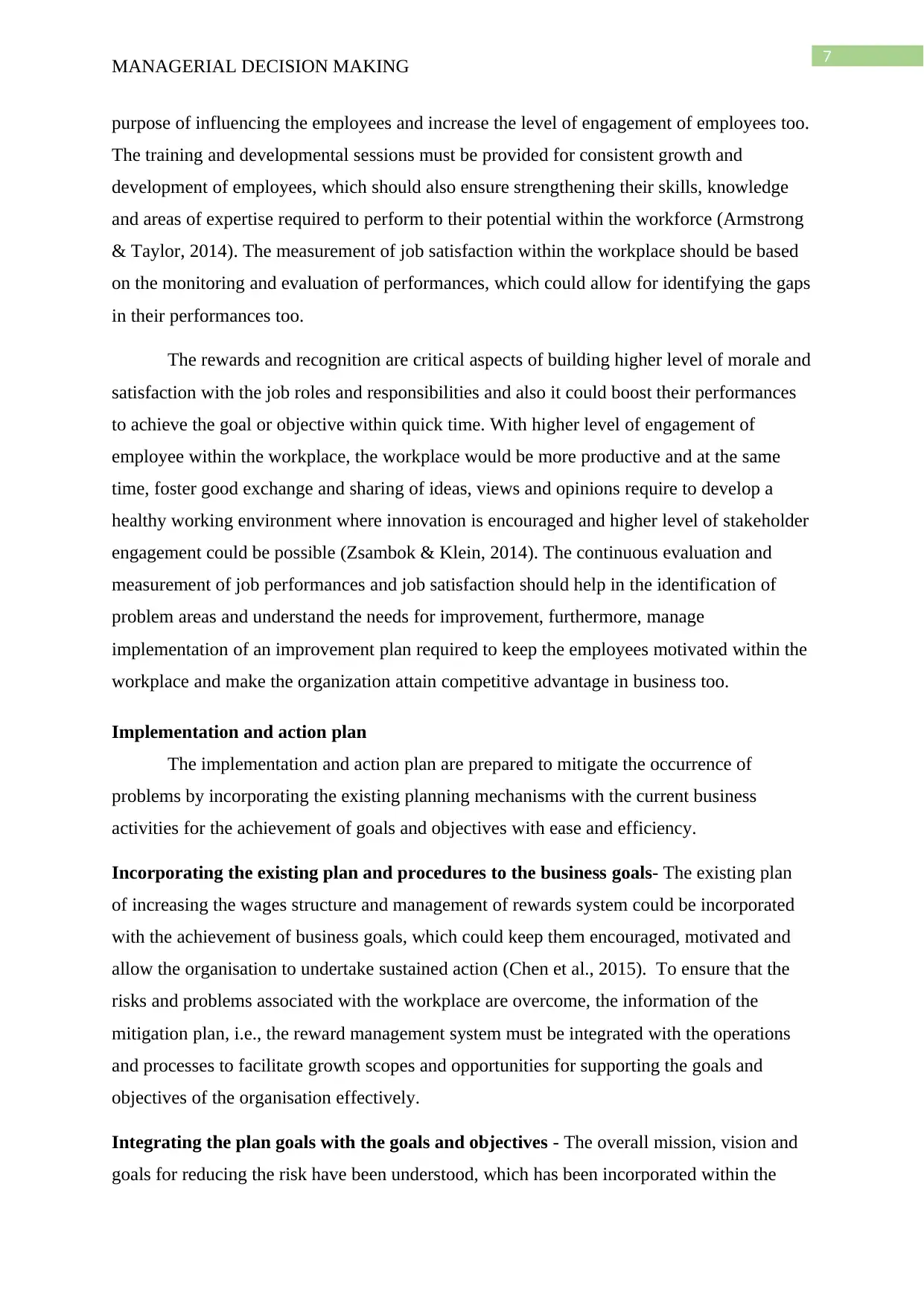
7
MANAGERIAL DECISION MAKING
purpose of influencing the employees and increase the level of engagement of employees too.
The training and developmental sessions must be provided for consistent growth and
development of employees, which should also ensure strengthening their skills, knowledge
and areas of expertise required to perform to their potential within the workforce (Armstrong
& Taylor, 2014). The measurement of job satisfaction within the workplace should be based
on the monitoring and evaluation of performances, which could allow for identifying the gaps
in their performances too.
The rewards and recognition are critical aspects of building higher level of morale and
satisfaction with the job roles and responsibilities and also it could boost their performances
to achieve the goal or objective within quick time. With higher level of engagement of
employee within the workplace, the workplace would be more productive and at the same
time, foster good exchange and sharing of ideas, views and opinions require to develop a
healthy working environment where innovation is encouraged and higher level of stakeholder
engagement could be possible (Zsambok & Klein, 2014). The continuous evaluation and
measurement of job performances and job satisfaction should help in the identification of
problem areas and understand the needs for improvement, furthermore, manage
implementation of an improvement plan required to keep the employees motivated within the
workplace and make the organization attain competitive advantage in business too.
Implementation and action plan
The implementation and action plan are prepared to mitigate the occurrence of
problems by incorporating the existing planning mechanisms with the current business
activities for the achievement of goals and objectives with ease and efficiency.
Incorporating the existing plan and procedures to the business goals- The existing plan
of increasing the wages structure and management of rewards system could be incorporated
with the achievement of business goals, which could keep them encouraged, motivated and
allow the organisation to undertake sustained action (Chen et al., 2015). To ensure that the
risks and problems associated with the workplace are overcome, the information of the
mitigation plan, i.e., the reward management system must be integrated with the operations
and processes to facilitate growth scopes and opportunities for supporting the goals and
objectives of the organisation effectively.
Integrating the plan goals with the goals and objectives - The overall mission, vision and
goals for reducing the risk have been understood, which has been incorporated within the
MANAGERIAL DECISION MAKING
purpose of influencing the employees and increase the level of engagement of employees too.
The training and developmental sessions must be provided for consistent growth and
development of employees, which should also ensure strengthening their skills, knowledge
and areas of expertise required to perform to their potential within the workforce (Armstrong
& Taylor, 2014). The measurement of job satisfaction within the workplace should be based
on the monitoring and evaluation of performances, which could allow for identifying the gaps
in their performances too.
The rewards and recognition are critical aspects of building higher level of morale and
satisfaction with the job roles and responsibilities and also it could boost their performances
to achieve the goal or objective within quick time. With higher level of engagement of
employee within the workplace, the workplace would be more productive and at the same
time, foster good exchange and sharing of ideas, views and opinions require to develop a
healthy working environment where innovation is encouraged and higher level of stakeholder
engagement could be possible (Zsambok & Klein, 2014). The continuous evaluation and
measurement of job performances and job satisfaction should help in the identification of
problem areas and understand the needs for improvement, furthermore, manage
implementation of an improvement plan required to keep the employees motivated within the
workplace and make the organization attain competitive advantage in business too.
Implementation and action plan
The implementation and action plan are prepared to mitigate the occurrence of
problems by incorporating the existing planning mechanisms with the current business
activities for the achievement of goals and objectives with ease and efficiency.
Incorporating the existing plan and procedures to the business goals- The existing plan
of increasing the wages structure and management of rewards system could be incorporated
with the achievement of business goals, which could keep them encouraged, motivated and
allow the organisation to undertake sustained action (Chen et al., 2015). To ensure that the
risks and problems associated with the workplace are overcome, the information of the
mitigation plan, i.e., the reward management system must be integrated with the operations
and processes to facilitate growth scopes and opportunities for supporting the goals and
objectives of the organisation effectively.
Integrating the plan goals with the goals and objectives - The overall mission, vision and
goals for reducing the risk have been understood, which has been incorporated within the
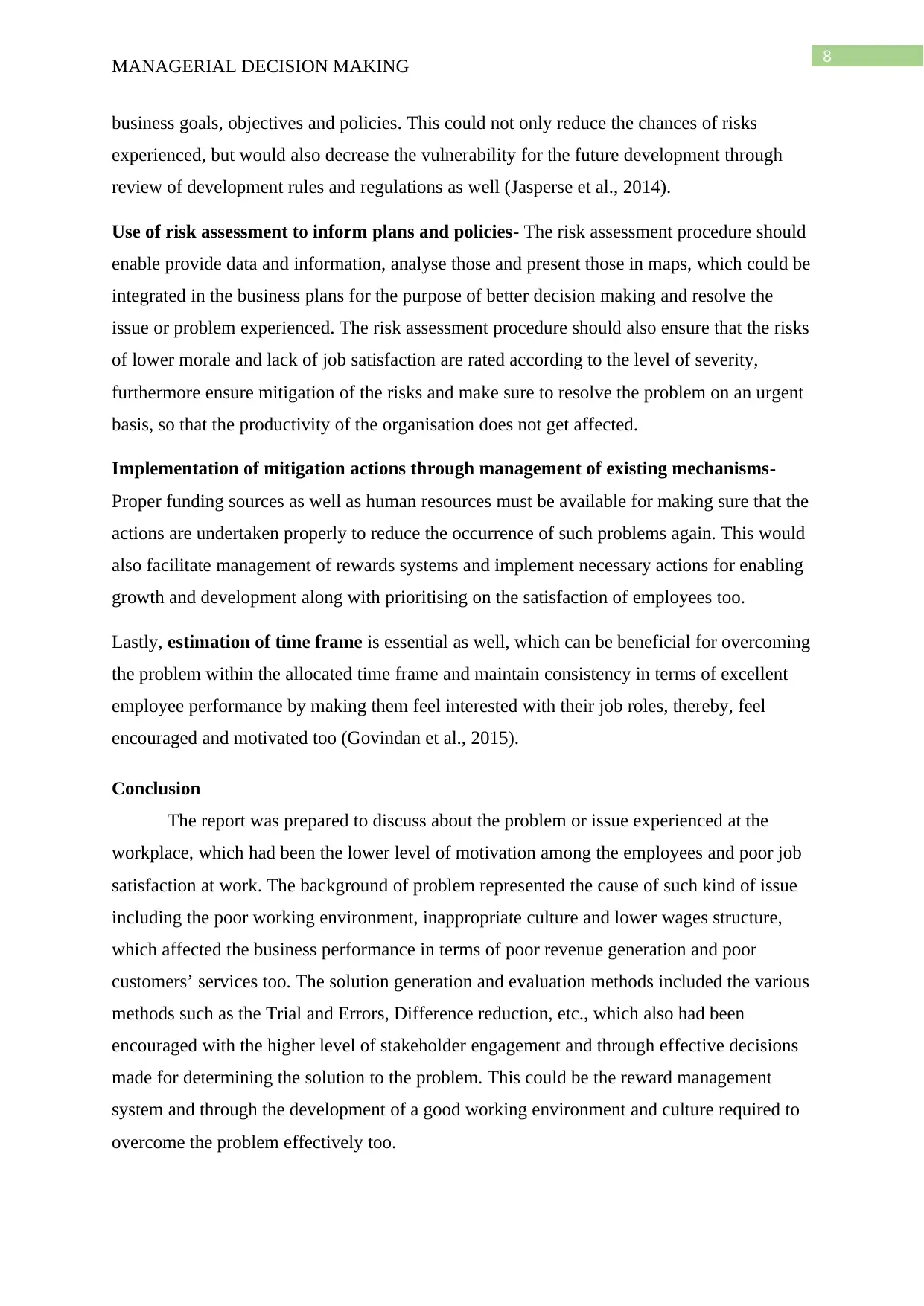
8
MANAGERIAL DECISION MAKING
business goals, objectives and policies. This could not only reduce the chances of risks
experienced, but would also decrease the vulnerability for the future development through
review of development rules and regulations as well (Jasperse et al., 2014).
Use of risk assessment to inform plans and policies- The risk assessment procedure should
enable provide data and information, analyse those and present those in maps, which could be
integrated in the business plans for the purpose of better decision making and resolve the
issue or problem experienced. The risk assessment procedure should also ensure that the risks
of lower morale and lack of job satisfaction are rated according to the level of severity,
furthermore ensure mitigation of the risks and make sure to resolve the problem on an urgent
basis, so that the productivity of the organisation does not get affected.
Implementation of mitigation actions through management of existing mechanisms-
Proper funding sources as well as human resources must be available for making sure that the
actions are undertaken properly to reduce the occurrence of such problems again. This would
also facilitate management of rewards systems and implement necessary actions for enabling
growth and development along with prioritising on the satisfaction of employees too.
Lastly, estimation of time frame is essential as well, which can be beneficial for overcoming
the problem within the allocated time frame and maintain consistency in terms of excellent
employee performance by making them feel interested with their job roles, thereby, feel
encouraged and motivated too (Govindan et al., 2015).
Conclusion
The report was prepared to discuss about the problem or issue experienced at the
workplace, which had been the lower level of motivation among the employees and poor job
satisfaction at work. The background of problem represented the cause of such kind of issue
including the poor working environment, inappropriate culture and lower wages structure,
which affected the business performance in terms of poor revenue generation and poor
customers’ services too. The solution generation and evaluation methods included the various
methods such as the Trial and Errors, Difference reduction, etc., which also had been
encouraged with the higher level of stakeholder engagement and through effective decisions
made for determining the solution to the problem. This could be the reward management
system and through the development of a good working environment and culture required to
overcome the problem effectively too.
MANAGERIAL DECISION MAKING
business goals, objectives and policies. This could not only reduce the chances of risks
experienced, but would also decrease the vulnerability for the future development through
review of development rules and regulations as well (Jasperse et al., 2014).
Use of risk assessment to inform plans and policies- The risk assessment procedure should
enable provide data and information, analyse those and present those in maps, which could be
integrated in the business plans for the purpose of better decision making and resolve the
issue or problem experienced. The risk assessment procedure should also ensure that the risks
of lower morale and lack of job satisfaction are rated according to the level of severity,
furthermore ensure mitigation of the risks and make sure to resolve the problem on an urgent
basis, so that the productivity of the organisation does not get affected.
Implementation of mitigation actions through management of existing mechanisms-
Proper funding sources as well as human resources must be available for making sure that the
actions are undertaken properly to reduce the occurrence of such problems again. This would
also facilitate management of rewards systems and implement necessary actions for enabling
growth and development along with prioritising on the satisfaction of employees too.
Lastly, estimation of time frame is essential as well, which can be beneficial for overcoming
the problem within the allocated time frame and maintain consistency in terms of excellent
employee performance by making them feel interested with their job roles, thereby, feel
encouraged and motivated too (Govindan et al., 2015).
Conclusion
The report was prepared to discuss about the problem or issue experienced at the
workplace, which had been the lower level of motivation among the employees and poor job
satisfaction at work. The background of problem represented the cause of such kind of issue
including the poor working environment, inappropriate culture and lower wages structure,
which affected the business performance in terms of poor revenue generation and poor
customers’ services too. The solution generation and evaluation methods included the various
methods such as the Trial and Errors, Difference reduction, etc., which also had been
encouraged with the higher level of stakeholder engagement and through effective decisions
made for determining the solution to the problem. This could be the reward management
system and through the development of a good working environment and culture required to
overcome the problem effectively too.
⊘ This is a preview!⊘
Do you want full access?
Subscribe today to unlock all pages.

Trusted by 1+ million students worldwide
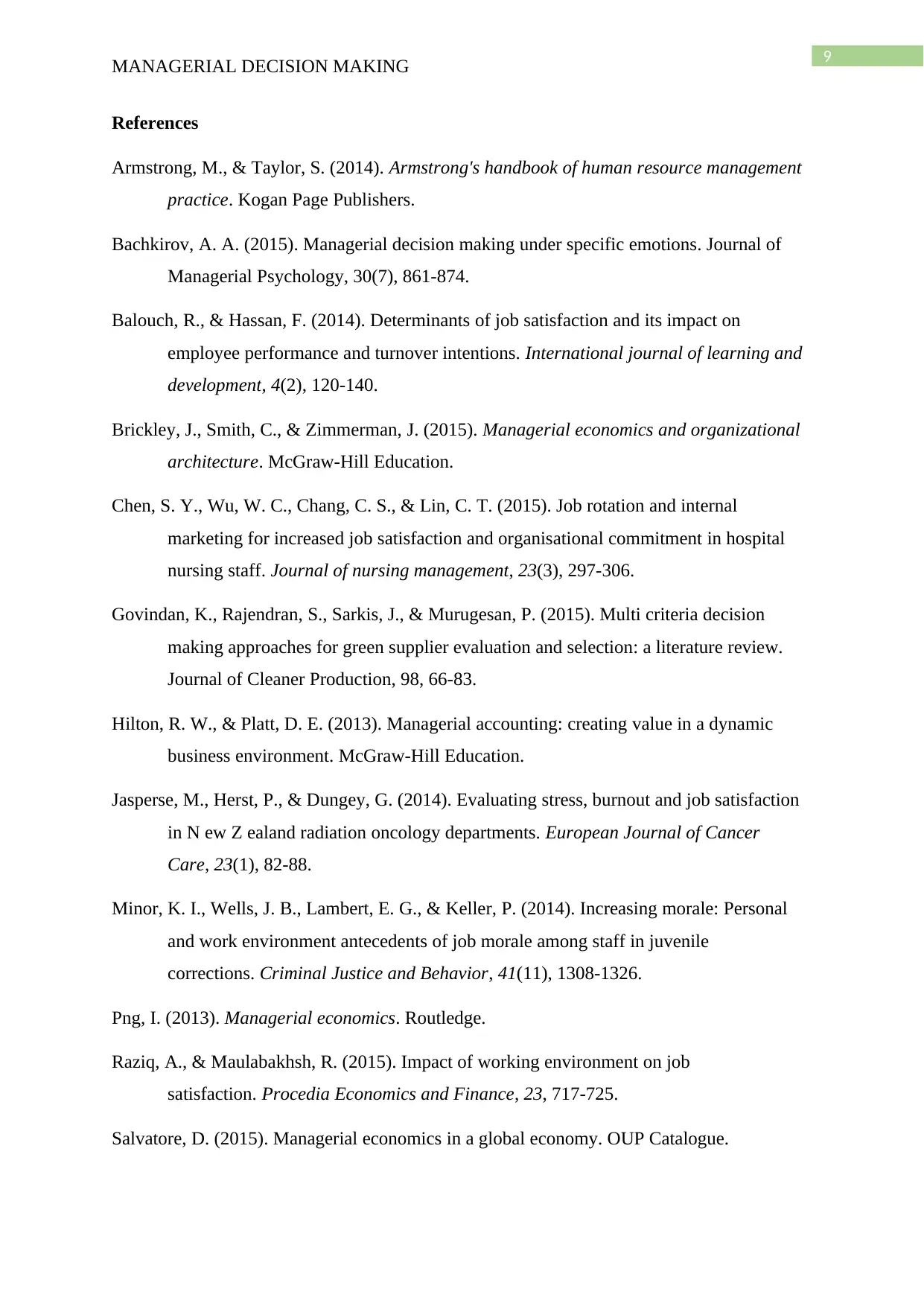
9
MANAGERIAL DECISION MAKING
References
Armstrong, M., & Taylor, S. (2014). Armstrong's handbook of human resource management
practice. Kogan Page Publishers.
Bachkirov, A. A. (2015). Managerial decision making under specific emotions. Journal of
Managerial Psychology, 30(7), 861-874.
Balouch, R., & Hassan, F. (2014). Determinants of job satisfaction and its impact on
employee performance and turnover intentions. International journal of learning and
development, 4(2), 120-140.
Brickley, J., Smith, C., & Zimmerman, J. (2015). Managerial economics and organizational
architecture. McGraw-Hill Education.
Chen, S. Y., Wu, W. C., Chang, C. S., & Lin, C. T. (2015). Job rotation and internal
marketing for increased job satisfaction and organisational commitment in hospital
nursing staff. Journal of nursing management, 23(3), 297-306.
Govindan, K., Rajendran, S., Sarkis, J., & Murugesan, P. (2015). Multi criteria decision
making approaches for green supplier evaluation and selection: a literature review.
Journal of Cleaner Production, 98, 66-83.
Hilton, R. W., & Platt, D. E. (2013). Managerial accounting: creating value in a dynamic
business environment. McGraw-Hill Education.
Jasperse, M., Herst, P., & Dungey, G. (2014). Evaluating stress, burnout and job satisfaction
in N ew Z ealand radiation oncology departments. European Journal of Cancer
Care, 23(1), 82-88.
Minor, K. I., Wells, J. B., Lambert, E. G., & Keller, P. (2014). Increasing morale: Personal
and work environment antecedents of job morale among staff in juvenile
corrections. Criminal Justice and Behavior, 41(11), 1308-1326.
Png, I. (2013). Managerial economics. Routledge.
Raziq, A., & Maulabakhsh, R. (2015). Impact of working environment on job
satisfaction. Procedia Economics and Finance, 23, 717-725.
Salvatore, D. (2015). Managerial economics in a global economy. OUP Catalogue.
MANAGERIAL DECISION MAKING
References
Armstrong, M., & Taylor, S. (2014). Armstrong's handbook of human resource management
practice. Kogan Page Publishers.
Bachkirov, A. A. (2015). Managerial decision making under specific emotions. Journal of
Managerial Psychology, 30(7), 861-874.
Balouch, R., & Hassan, F. (2014). Determinants of job satisfaction and its impact on
employee performance and turnover intentions. International journal of learning and
development, 4(2), 120-140.
Brickley, J., Smith, C., & Zimmerman, J. (2015). Managerial economics and organizational
architecture. McGraw-Hill Education.
Chen, S. Y., Wu, W. C., Chang, C. S., & Lin, C. T. (2015). Job rotation and internal
marketing for increased job satisfaction and organisational commitment in hospital
nursing staff. Journal of nursing management, 23(3), 297-306.
Govindan, K., Rajendran, S., Sarkis, J., & Murugesan, P. (2015). Multi criteria decision
making approaches for green supplier evaluation and selection: a literature review.
Journal of Cleaner Production, 98, 66-83.
Hilton, R. W., & Platt, D. E. (2013). Managerial accounting: creating value in a dynamic
business environment. McGraw-Hill Education.
Jasperse, M., Herst, P., & Dungey, G. (2014). Evaluating stress, burnout and job satisfaction
in N ew Z ealand radiation oncology departments. European Journal of Cancer
Care, 23(1), 82-88.
Minor, K. I., Wells, J. B., Lambert, E. G., & Keller, P. (2014). Increasing morale: Personal
and work environment antecedents of job morale among staff in juvenile
corrections. Criminal Justice and Behavior, 41(11), 1308-1326.
Png, I. (2013). Managerial economics. Routledge.
Raziq, A., & Maulabakhsh, R. (2015). Impact of working environment on job
satisfaction. Procedia Economics and Finance, 23, 717-725.
Salvatore, D. (2015). Managerial economics in a global economy. OUP Catalogue.
Paraphrase This Document
Need a fresh take? Get an instant paraphrase of this document with our AI Paraphraser
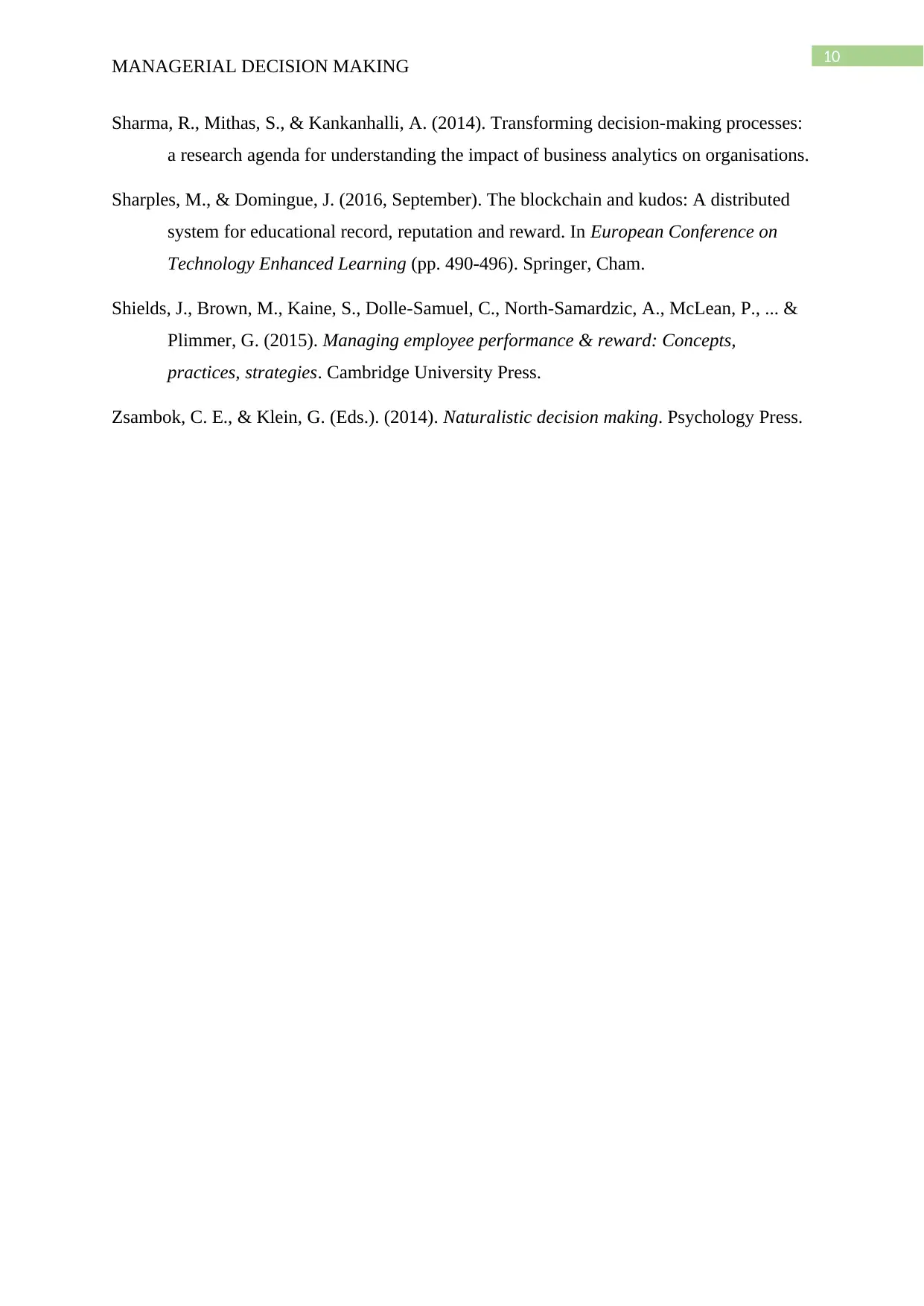
10
MANAGERIAL DECISION MAKING
Sharma, R., Mithas, S., & Kankanhalli, A. (2014). Transforming decision-making processes:
a research agenda for understanding the impact of business analytics on organisations.
Sharples, M., & Domingue, J. (2016, September). The blockchain and kudos: A distributed
system for educational record, reputation and reward. In European Conference on
Technology Enhanced Learning (pp. 490-496). Springer, Cham.
Shields, J., Brown, M., Kaine, S., Dolle-Samuel, C., North-Samardzic, A., McLean, P., ... &
Plimmer, G. (2015). Managing employee performance & reward: Concepts,
practices, strategies. Cambridge University Press.
Zsambok, C. E., & Klein, G. (Eds.). (2014). Naturalistic decision making. Psychology Press.
MANAGERIAL DECISION MAKING
Sharma, R., Mithas, S., & Kankanhalli, A. (2014). Transforming decision-making processes:
a research agenda for understanding the impact of business analytics on organisations.
Sharples, M., & Domingue, J. (2016, September). The blockchain and kudos: A distributed
system for educational record, reputation and reward. In European Conference on
Technology Enhanced Learning (pp. 490-496). Springer, Cham.
Shields, J., Brown, M., Kaine, S., Dolle-Samuel, C., North-Samardzic, A., McLean, P., ... &
Plimmer, G. (2015). Managing employee performance & reward: Concepts,
practices, strategies. Cambridge University Press.
Zsambok, C. E., & Klein, G. (Eds.). (2014). Naturalistic decision making. Psychology Press.
1 out of 11
Related Documents
Your All-in-One AI-Powered Toolkit for Academic Success.
+13062052269
info@desklib.com
Available 24*7 on WhatsApp / Email
![[object Object]](/_next/static/media/star-bottom.7253800d.svg)
Unlock your academic potential
Copyright © 2020–2025 A2Z Services. All Rights Reserved. Developed and managed by ZUCOL.





